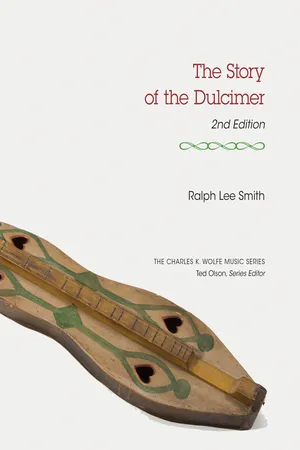The Story of the Dulcimer
About this book
"This is a fascinating, well-researched text that scholars, musicians, collectors, and luthiers will treasure as a gem of information.”
—Scott Suter, author of Shenandoah Valley Folklife
Perhaps no instrument better represents the music of Appalachia than the fretted dulcimer. The instrument was no longer confined to back porches and local music halls when Jean Ritchie so melodically thrust herself and her dulcimer into the national limelight during the folk revival of the 1950s. But where did the dulcimer, known to exist in no other folk culture in the world, come from?
In The Story of the Dulcimer, Ralph Lee Smith traces the dulcimer’s beginnings back to European immigration to America in the eighteenth and early nineteenth centuries. As German immigrants settled in Pennsylvania and Appalachia, they brought with them scheitholts, a type of northern European fretted zither. As German immigrants intermingled with English and Scotch-Irish immigrants, the scheitholt, which was customarily played to a slower tempo in German cultural music, began to be musically integrated into the faster tempos of English and Scotch-Irish ballads and folk songs. As Appalachia absorbed an increasing flow of English and Scotch-Irish immigrants and the musical traditions they brought with them, the scheitholt steadily evolved into an instrument that reflected this folk music amalgamation, and the modern dulcimer was born.
In this second edition, Smith brings the dulcimer’s history into the twenty-first century with a new preface and updates to the original edition. Copiously illustrated with images of both antique scheitholts and contemporary dulcimers, The Story of the Dulcimer is a testament to the enduring musical heritage of Appalachia and solves one of the region’s musical mysteries.
RALPH LEE SMITH is a musician specializing in traditional Appalachian music and, along with the late Jean Ritchie, is widely regarded as the leading authority on the music and history of the dulcimer. He is the author of seven collections of folk songs relating to the dulcimer. He recently published a memoir/songbook, Greenwich Village: The Happy Folk Singing Days, 1950s–1960s, which recounts his time in New York City during the folk revival.
Frequently asked questions
- Essential is ideal for learners and professionals who enjoy exploring a wide range of subjects. Access the Essential Library with 800,000+ trusted titles and best-sellers across business, personal growth, and the humanities. Includes unlimited reading time and Standard Read Aloud voice.
- Complete: Perfect for advanced learners and researchers needing full, unrestricted access. Unlock 1.4M+ books across hundreds of subjects, including academic and specialized titles. The Complete Plan also includes advanced features like Premium Read Aloud and Research Assistant.
Please note we cannot support devices running on iOS 13 and Android 7 or earlier. Learn more about using the app.
Information
Table of contents
- Contents
- Foreword
- Preface to the Second Edition
- Preface to the First Edition
- Acknowledgments
- Chapter 1. An American Folk Heritage
- Chapter 2. Peoples of the Frontier
- Chapter 3. The Trail of the Scheitholt
- Chapter 4. Searching for the Beginnings
- Chapter 5. The Flowering of the Virginia Style
- Chapter 6. The Hourglass Dulcimer
- Postscript. What Ever Became of the Scheitholt?
- Appendix A. Catalog of Instruments
- Appendix B. Vibrating String Lengths
- Appendix C. Dimensions of Huntington and Thomas Dulcimers
- Appendix D. The Preservers
- Appendix E. An 1817 Dulcimer?
- Notes
